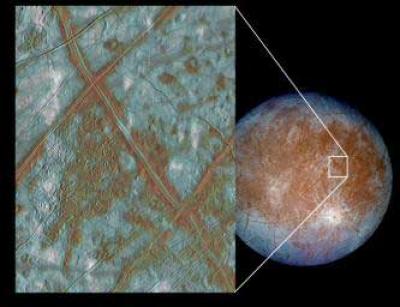NASA has just announced that it has selected Northrop Grumman Space Technology as the contractor for co-designing its proposed Jupiter Icy Moons Orbiter. JIMO will be designed to orbit and explore three of the most interesting Jovian moons: Callisto, Ganymede and Europa. All three may possess water, organic material and a source of energy, leading to the possibility of some form of life evolving there.

Image: The surface of Europa as seen by the Galileo orbiter. Note the crustal blocks on the left that seem to have once broken apart, and then ‘rafted’ into their current positions. They’re evidence of what may be a sub-surface ocean. Credit: Planetary Image Research Laboratory, University of Arizona.
Studying these moons closely will involve long periods in orbit around each before moving on to the next target. The propulsion system envisioned here is nuclear electric. NASA’s Deep Space 1 spacecraft has already demonstrated the principle, in which electrically charged particles are expelled to produce thrust. In contrast to Deep Space 1, which used solar arrays to power the system, JIMO will carry a small nuclear reactor, and would also tap the power of the reactor for its science investigations, with significant benefits to the mission.
NASA’s Prometheus Project is charged with developing the nuclear power options for JIMO. According to the agency’s FAQ on Prometheus: “The amount of power available from a nuclear reactor – potentially hundreds of times greater than that available to current interplanetary spacecraft — would enable delivery of larger payloads with vastly more capable instruments and faster data transmission back to Earth than such missions as Voyager, Galileo, and Cassini. In addition, because extremely fuel-efficient electric thrusters would propel the spacecraft, mission planners could make course adjustments throughout the mission in response to real-time discoveries.”

